[Page 233]Abstract: The story of Joseph Smith retrieving gold plates from a stone box on a hillside in upstate New York and translating them into the foundational text of the Restoration is well known among Latter-day Saints. While countless retellings have examined these events in considerable detail, very few have explored the geological aspects involved in this story. In particular, none have discussed in detail the geological materials that would have been required by the Nephite prophet Moroni ca. ad 421 to construct a sealed container able to protect the gold plates from the elements and from premature discovery for some fourteen centuries. This paper reports the outcomes from a field investigation into what resources would have been available to Moroni in the Palmyra area. It was conducted by the authors in New York state in October 2017.
The hill near Palmyra,1 New York state, in which Moroni buried the plates and from which Joseph Smith retrieved them, has long been popularly known among Latter-day Saints as “Cumorah.” This unofficial practice derived from the assumption by many early Book of Mormon believers that this hill marks the location of the final battles between the Lamanite and Nephite armies. The practice remains common today among the general membership. As the Book of Mormon describes the land of Cumorah, its hill, and those wars in some detail, it is evident to [Page 234]the careful reader that the real-world setting was not — indeed could not — have been situated in New York state.2 Accordingly, for clarity throughout this paper, the New York hill where the plates were buried by Moroni is referred to as the “Palmyra hill.”
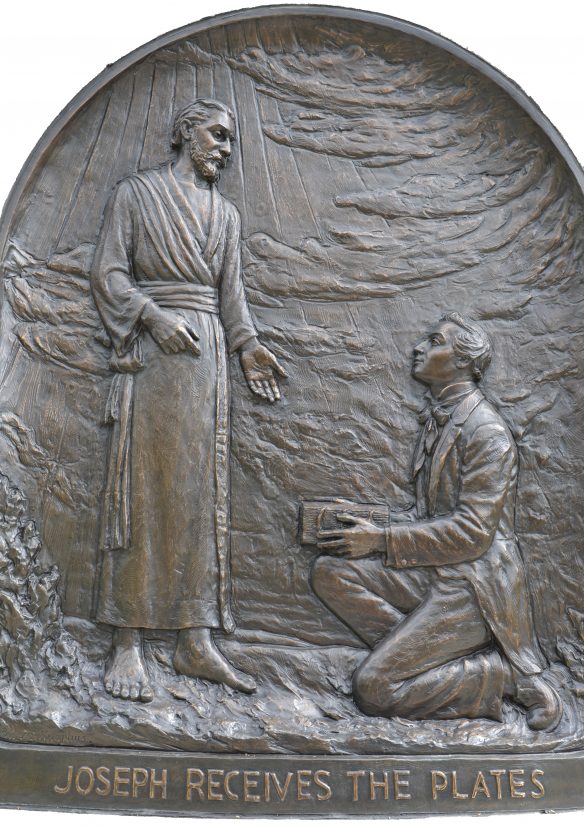
Image 1. Joseph receives the plates from Moroni. Relief on the west side of the monument atop the Palmyra hill. W. Aston photography.
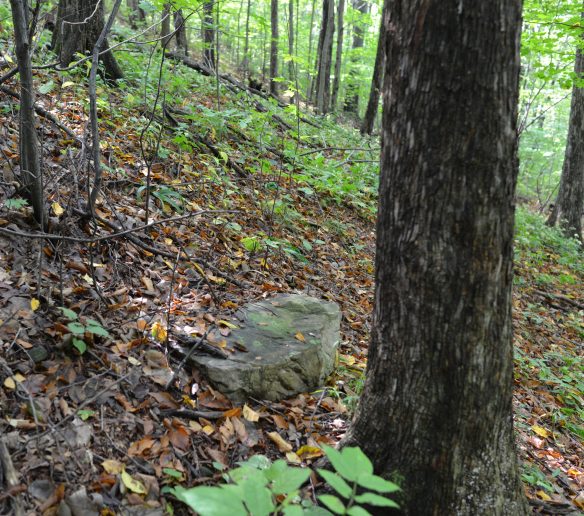
Image 2. A general view, facing south, of the west side of the Palmyra hill, near the summit. This is the general area where Moroni buried the plates. Large flat-faced rocks, like those shown in the foreground, are common on the hill. W. Aston photography.
[Page 235]From Mormon’s Cumorah to Moroni’s Hill
The final, decisive battle bringing about the end of Nephite society took place about ad 385 (recounted in Mormon 6:1–15) around the Hill Cumorah, the same location formerly known as the Hill Ramah, where the Jaredite nation had earlier ended in battle (Ether 15:11). As the leader of his people, Mormon had buried the collected records of his people in the Hill Cumorah, entrusting his abridgement of them to his son Moroni (Mormon 6:6). Mormon died in the ultimate battle, leaving Moroni to protect and even add to the Nephite record while still avoiding the victorious Lamanites as he wandered.
Three and a half decades later (about ad 421; see Moroni 10:1), Moroni ends his writing and prepares to bury the sacred items in a hill. The years of travel had brought him northward to the Palmyra area of upstate New York, [Page 236]where the cooler climate would aid in the preservation of buried materials and where they would be accessible when required in the Restoration.
Realistically, for the three decades of wandering that brought him to the Palmyra area, Moroni could not have carried heavy items such as sizeable rocks in addition to the metal plates, breastplate, sword of Laban, Liahona, and the Urim and Thummim, as listed in the 1829 revelation to the Three Witnesses (Doctrine and Covenants 17:1). By his own account completely alone (Mormon 8:3, 5), we feel safe in concluding that when the time arrived to bury the plates, Moroni was restricted to local materials on hand in the Palmyra area.
A Geological Introduction to the Palmyra Setting
The Palmyra hill is a large glacial drumlin, formed during the last ice age. It belongs to a large region of drumlins that lie between Lake Ontario on the north and New York’s Finger Lakes to the south.3 Understanding how the drumlins formed is important to understanding the findings that follow; it also offers insights into why this particular location would become the place for Moroni to secure his precious record.
During the ice age, a vast glacier of continental proportions, known to geologists as the Laurentide Ice Sheet, flowed southwards from Canada and across the Great Lakes region. As it moved across the landscape, the glacier eroded and carried along large amounts of mixed and very poorly sorted sediments that included clays, silts, sands, gravels and boulders in various combinations.4
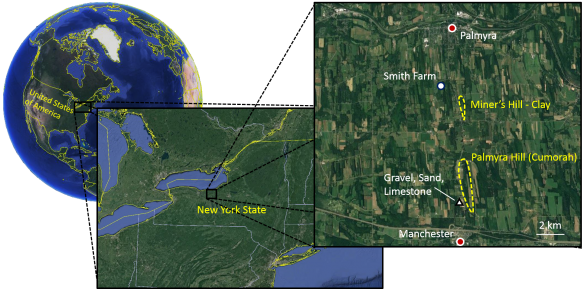
Image 3. Map of the location of the Palmyra hill in upstate New York State, USA, and its relationship to geologic resources that were necessary to build Moroni’s stone box as described by Joseph Smith and Oliver Cowdery. Background image courtesy of Google Earth. Graphic courtesy B. Jordan
These materials were deposited as hills elongated in the general direction of the glacier’s flow, with the highest point of the hill being “uphill” of the glacier’s flow direction and tapering down in the glacier’s [Page 238]flow direction.5 The highest point of the Palmyra hill lies, therefore, at its north end, with the long slope of the hill tapering away to the south.

Image 4. The drumlin field in the area. Graphic courtesy B. Jordan.
In the Palmyra area, most of the drumlins consist of a mix of stratified or layered gravels and sands. However, near the Palmyra hill is one today named Miners Hill, which is an exception: it is predominately formed of clay — something that might well have played an important role in the making of Moroni’s stone box. This hill will be discussed shortly.
Also of possible relevance is the fact that the sides of drumlin hills tend to be steeply sloped compared with other sedimentary hills; this is very evident at the Palmyra hill. The high angle of the slope would place the box above the local water table by ensuring more efficient water [Page 239]runoff and preventing the accumulation of water around the box. This may be why Moroni chose to place the box near the top of the hill.
On the other hand, faster water flow would likely have led to more rapid erosion in addition to the natural creep of soil downhill over time. Thus it is possible, if not likely, that the stone box was buried deep enough by Moroni to be completely covered by soil until erosion exposed its upper surface by Joseph’s time.

Image 5. Panoramic photograph showing the profile of the Palmyra hill, facing east.
B. Jordan photography
A Description of Moroni’s Stone Box
Joseph Smith described the box and its location: “On the west side of this hill, not far from the top,6 under a stone of considerable size, lay the plates, deposited in a stone box. This stone was thick and rounding in the middle on the upper side, and thinner towards the edges, so that the middle part of it was visible above the ground, but the edge all around was covered with earth. … The box in which they lay was formed by laying stones together in some kind of cement. In the bottom of the box were laid two stones crossways of the box, and on these stones lay the plates and the other things with them.”7
Another description of the box was given by Oliver Cowdery, who said a hole was dug in the hill and, “[a]t the bottom of this was laid a stone of suitable size, the upper surface being smooth. At each edge was placed a large quantity of cement, and into this cement, at the four edges of this stone, were placed, erect, four others, their bottom edges resting in the cement at the outer edges of the first stone. The four last named, when placed erect, formed a box, the corners, or where the edges of the four came in contact, were also cemented so firmly that the moisture from [Page 240]without was prevented from entering. It is to be observed, also, that the inner surface of the four erect, or side stones was smooth.”8
Oliver goes on to describe the relative dimensions of the box, including the fact that it “was sufficiently large to admit a breast-plate, such as was used by the ancients to defend the chest, etc. from the arrows and weapons of their enemy. From the bottom of the box, or from the breast-plate, arose three small pillars composed of the same description of cement used on the edges; and upon these three pillars was placed the record of the children of Joseph.”9 For the purposes of this study, however, our focus will remain on the nature of the construction materials: stones and cement.
Rocks Available to Moroni in Making the Box
With these descriptions in mind, a comprehensive survey of the ground on all sides of the Palmyra hill and its surroundings was conducted by the authors, taking particular note of the description that the rocks that made up the box were smooth on at least one of their sides. The survey examined rocks in all possible settings, in situ on the hill slopes, walls of rocks cleared from fields, and rocks incorporated into landscape features and buildings.
Given the drumlin nature of the hill, the material of the hill consists of a wide variety of sedimentary material, large and small. Large cobbles (naturally rounded rocks up to about 25 cm/10 inches across) and larger boulders of the size necessary to form the box remain widely distributed across the surface of the hill and throughout the surrounding landscape. In particular, cobble to boulder-size rocks of laminated sandstone and rounded granite and gneiss are fairly common (see image 7A).
One question that arises is what Oliver meant by his use of the word “smooth” in order to determine which rock type is likely to have been used in the creation of the box. The sandstone cobbles consist of a fine grained, slightly-reddish tan color, quartz-rich sandstone with a rounded outer surface. They easily split along lamination surfaces to form fairly smooth, flat surfaces that could fit Oliver’s description of the box (see image 7B). Another common rock found was eroded or rounded pieces of light gray-pink colored granite and gneiss, many of which had at least one side that was flat and smooth. Although their surfaces are not as flat, they are smoother than the sandstone (see images 7C and 7D).
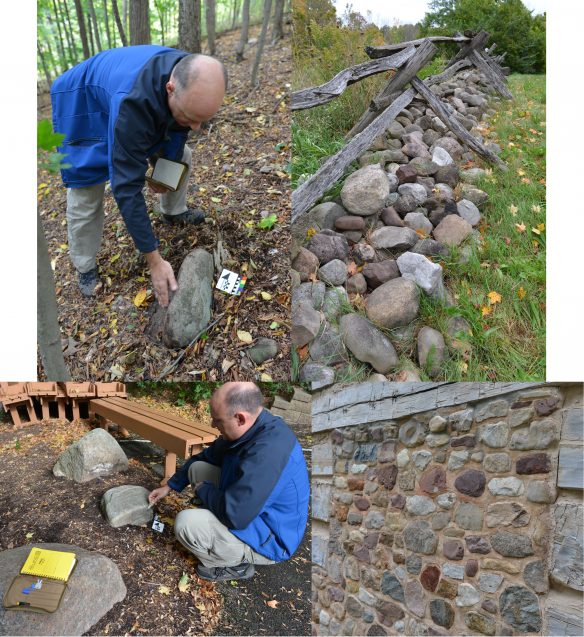
Image 6. The survey examined local rocks from a variety of settings. Clockwise from
top left: in situ on the Palmyra hill, rocks cleared from fields, rocks incorporated
into landscaping, and rocks incorporated into buildings. W. Aston photography.
[Page 241]It is worth noting, though, that as Oliver said the cement was prepared and placed in such a way that the rocks were “cemented so firmly that the moisture from without was prevented from entering,” the type of rock was likely important for another reason. One advantage in using granite over sandstone is that granite is generally much less porous than sandstone, thus sealing out moisture more effectively. This, coupled with the porous nature of the unconsolidated sediments that form the hill, would have allowed efficient water drainage from around the stone box. Any moisture that did not drain away would be kept from the box interior by the fine cement and the stone sides shaped, most likely, of granite.
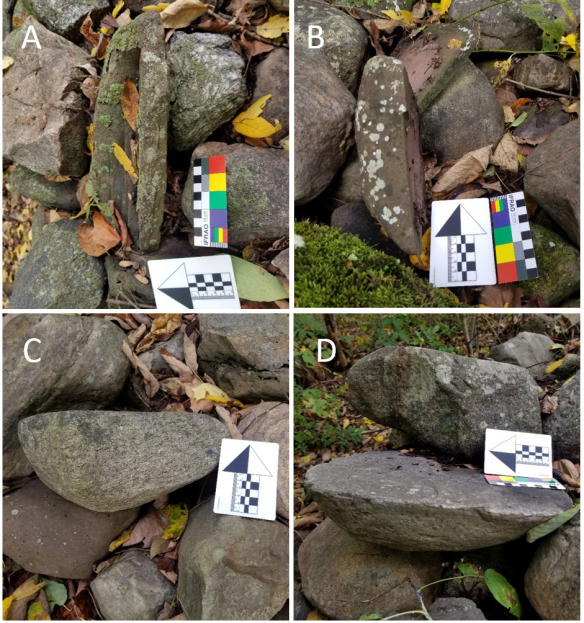
Image 7. Rocks found in the vicinity of the Palmyra hill fitting the description of those used to make Moroni’s stone box. Images A and B consist of rounded, but delaminated, sandstone. C and D are rounded cobbles of granite. B. Jordan photography.
[Page 242]Our investigation to determine if rocks, as described by eye-witnesses, were available in or near the place of burial to form the box demonstrates clearly that they were and, indeed, still are.
What Might Moroni Have Already Known about Cement?
A reasonable question at this point is: could Moroni have known how to make the cement that was vital to construction of the box? Or would he have required assistance, either divine instructions or a helper?
[Page 243]The answer to this question comes from the Book of Mormon itself, which describes that around 49–39 bc, hundreds of years before Moroni’s time, the ancient Nephites:
became exceedingly expert in the working of cement; therefore they did build houses of cement, in the which they did dwell … And thus they did enable the people in the land northward that they might build many cities, both of wood and of cement. (Helaman 3:7, 11)
Moroni thus grew up within a culture in which making cement using the abundant limestone of the region was already a common skill or technology. So it is entirely possible, even likely, that he learned the skill himself, needing no assistance when in Palmyra. We conclude that it is most unlikely, therefore, that Moroni would have needed recourse to either divine or human help in the matter. An examination of what is now known of the cement skills available in Moroni’s day now sheds considerable further light on what he did while at Palmyra.
Archaeological Evidence for Ancient Cement in the Americas
The reference just cited in the Book of Helaman to houses and even cities built of wood and “cement” was universally derided in Joseph Smith’s day; even well into the twentieth century awareness of the nature of structures in Mexico and Mesoamerican remained obscure among scholars and the public alike.
While the use of cement in the Book of Mormon period remains unknown in South America and in modern USA and Canada,10 today we know of hundreds of sites across Central America dating to that age — temples, pyramids, courtyards, palaces up to five stories high and other large buildings — constructed with, and sometimes largely composed of, high-quality concrete. These structures range up to 72 meters (236 feet) tall and can cover large areas. They have endured a humid climate, earthquakes, and hurricanes for up to three millennia and, despite the encroachment of jungle vines and roots since their abandonment around 1000 ad, have remained largely intact.
Archaeology has further established that while precursors appear among the Maya as early as the ninth century bc, cement and concrete skills first appear as a fully-developed technology in Mesoamerica [Page 244]around the very period described in Helaman, the first century bc,11 a most significant correlation with the Nephite text.
In 1973, Civil engineer David S. Hyman published the following summary of his research in terms that bear repeating:
I collected a comprehensive number of concrete, stucco, and mortar samples from many important sites throughout Mexico and Central America. … These were subjected to load tests, chemical, petrographic, x-ray diffraction, and other analyses … All cements proved to be pure or nearly pure calcium carbonate. Extreme hardness and durability of the finished concrete slab or stucco had been accomplished by purity of cement, incredible skill in proportioning and mixing with the aggregates and, in some cases, by the use of additives and surface hardeners .… [M]y earliest [dated] samples were of the highest quality.12
Ancient Maya cement, therefore, is essentially the same as modern Portland cement (the modern standard) and produces a strong matrix of concrete, comparable in every way to what is used in construction today.
The Ingredients of Durable Cement
Perhaps a greater challenge to Moroni than locating suitable rocks would have been finding materials suitable for producing high quality, hard wearing cement in a large enough quantity to hold the stones together. While we do not know the exact nature and type of “cement” that was made by him, the materials in the immediate environment offer strong clues.
As the box had to protect its contents for some 1400 years, something we can be certain of is that Moroni’s cement must have been of an enduring type, most likely similar to modern cements. The essential chemical ingredient of cement is calcium (Ca), produced from what is commonly known as quicklime, burnt lime, or simply lime (Calcium oxide, CaO) from either limestone or dolostone. Limestone is the easier of the two to process and thus the most preferable rock type; as already noted, limestone would have been familiar to Moroni from his own Nephite culture.
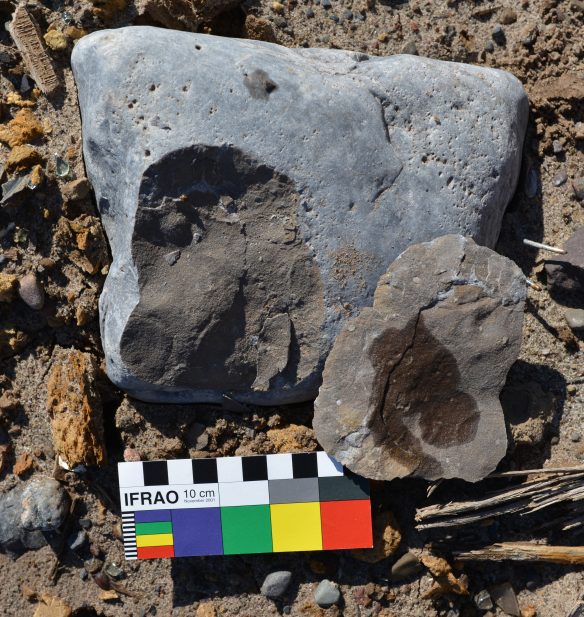
Image 8. A large cobble of Limestone with the interior exposed. W. Aston photography.
[Page 245]Producing lime in the pre-industrial period was a process that involved cooking pieces of limestone on a wood fire. Once the wood burnt down to charcoal, temperatures of up to around 1,600° C (~2,900° F) were reached.13 This resulted in a chemical reaction producing globules (“clinkers”) of calcium silicate (Ca2SiO4); after cooling, water added to the material made it expand to a powder of around 5 or 6 times the volume of the limestone. This was the cement which, added to an aggregate and water, formed concrete.
[Page 246]Within the local drumlin, gravels and the limestone cobbles mentioned earlier and pictured above are found; they are of an excellent quality for producing lime. Post fieldwork analysis established that these limestone rocks are high in the critical compound of Calcium Oxide, CaO.
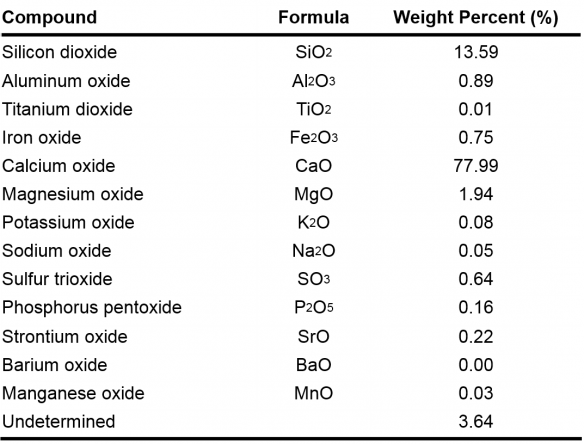
Image 9. Limestone analysis results. Courtesy of B. Jordan.
Of course, Moroni needed to burn wood to reduce the limestone to powder. Where this was done remains unclear, but the geography of the Palmyra hill may provide a clue. At the hill’s southwestern end is a small valley, or vale, situated between the hill and a low rise on the west that prevents anyone passing along the western side of the hill from seeing into the vale. Such a place could have provided him with the seclusion necessary to assemble the stone box and manufacture the cement while remaining undetected. With decades of experience avoiding detection in his long travels, probably making regular fires for cooking, we believe Moroni would have utilized such natural features as he worked to not draw attention to the actual burial location itself.
Modern cements primarily consist of a mixture of lime, sand, and clay. Our investigation found that all three of these materials exist in close proximity to the Palmyra hill, and in sufficient quantities to make the cement necessary to form a stone box of the size described by Joseph and Oliver.
Lime and Sand
Just to the west of the southern point of Palmyra Hill, at a distance of 1.7 km (1.09 miles), is an excavation of drumlin sediments that consists [Page 247]of alternating layers of medium to coarse-grained, cross-bedded sand and graded gravel, which is typical of drumlins.14
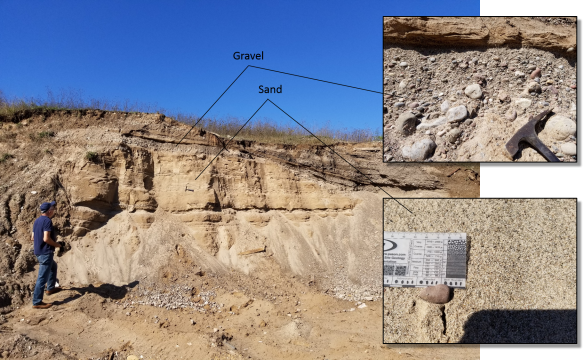
Image 10. The drumlin geology of the Palmyra area is revealed in the layers of sand, gravel, and limestone inclusions at this quarry just southwest of the hill. Within the gravel was limestone of a grade sufficient to produce lime. B. Jordan photography.
The majority of the drumlin material consists of sand; it is the gravel deposits that commonly contain cobble- and pebble-sized pieces of limestone. Additionally, there are sizeable bedrock outcrops of limestone in the area, as evidenced by a working limestone quarry (the Dolomite Products Company) ~7 km (~5 miles) southeast of the Palmyra hill. Limestone and dolostone quarries are New York’s second most common type of mine.15
Clay
As clay is almost unknown in the Palmyra area, the clay that Moroni needed was the most challenging ingredient for us to locate.16 As noted earlier, however, some 3 km (~2 miles) due north of the Palmyra hill is a smaller drumlin called Miner’s Hill. Perhaps uniquely in the area, this hill consists almost entirely of fine clay. According to the current land [Page 248]owner, who allowed the New York Highway Department to mine it, it is the only location in the area that serves as a source of clay.
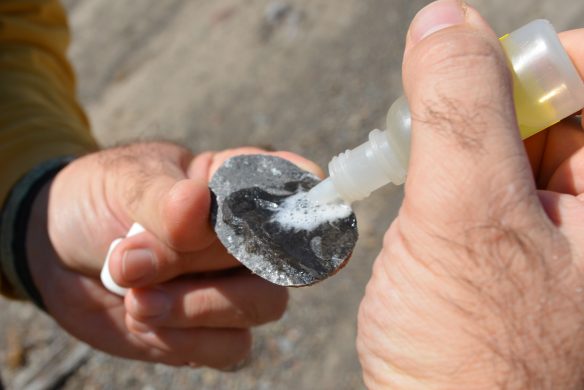
Image 11. Testing limestone with diluted hydrochloric acid. W. Aston photography.
Miner’s Hill lies between Joseph Smith’s family home and the Palmyra hill, a proximity that may be significant in the story of the plates. It also has a deep tunnel, recently re-excavated, offering a glimpse into the interior of the hill. The tunnel dates back to the Smith family’s time and is therefore of possible historic interest.17
What Happened to the Stone Box?
Understandably, in Joseph Smith’s day it was the contents of the box — the plates — that held the greatest interest to believers and unbelievers alike. Still, there were those in both camps who also sought to see the stone box on the hill for themselves. There are no reliable first-hand accounts of what happened to the stone box. However, the most credible reports agree that the stone box, its capstone having been opened several times by Joseph Smith in his meetings with the resurrected Moroni over the years, and seemingly left open after he removed its contents, was now exposed to the elements and eventually washed in pieces down the hill.
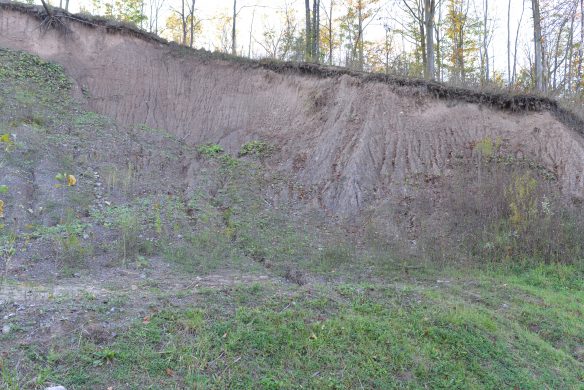
Image 12. Miner’s Hill in Palmyra is a rare drumlin consisting of fine clay. W. Aston photography.
[Page 249]Two surviving accounts are our sources for this likely outcome. The first was General Authority (First Council of the Seventy) Edward Stevenson (d. 1897) who published an account in 1893 about interviewing an “old man” living near the hill:
Questioning him closely he stated that he had seen some good-sized flat stones that had rolled down and lay near the bottom of the hill. This had occurred after the contents of the box had been removed and these stones were doubtless the ones that formerly composed the box. I felt a strong desire to see these ancient relics and told him I would be much pleased to have him inform me where they were to be found. He stated that they had long since been taken away.18
The other is a report in which David Whitmer, one of the Three Witnesses to the Book of Mormon, had stated:
Three times [David Whitmer] has been at the Hill Cumorah and seen the casket that contained the tablets and seerstone. [Page 250]Eventually the casket has been washed down to the foot of the hill, but it was to be seen when he last visited the historic place.19
What seems certain, at least, is that Moroni’s stone box is no longer in its original position on the hill nor, despite some claims to the contrary, does any indication of the hole remain where it was once buried.
The Unique Convergence of Geological
Factors in the Palmyra Area
The glacial processes of the Palmyra region brought together all the necessary materials to form the stone box, to manufacture the cement holding the stone components together, and fashion the three small cement pillars inside it. Moroni would have been able to access the rocks and sediments necessary without extensive travel or effort.
Considered individually, sandstone, granite, and limestone are all, of course, very common rocks on the surface of the Earth, as are sediments such as clays and sand. This is also true of the formation of flat-sided sandstones and granite as they weather. However, finding all these rocks and sediments together in close proximity is more unusual. While such a grouping may not be accurately described as rare on Earth, given the needs of Moroni it was highly advantageous to his purposes to have all these occur in the vicinity of the hill in which he buried the plates.
Joseph Smith noted in his History that the hill where he obtained the plates was a prominent landmark20 in an area where the terrain is quite flat and most hills appear nearly identical. This uniformity of size is common in drumlin fields and would have been especially true in Joseph Smith’s time, as much of the area had been deforested by settlers to make farmland. This prominence, coupled with the fact that the stone materials and all the cement ingredients are readily available in the vicinity, made the Palmyra hill uniquely situated for the purposes of Moroni.
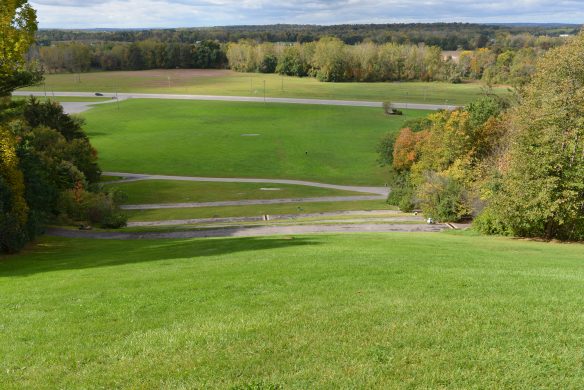
Image 13. The view facing west from the north end of the Palmyra hill. W. Aston photography.
Conclusion
This research answers two closely related questions:
- [Page 251]Were the geological materials necessary to make a stone box, consisting of sizable stones and the ingredients for cement, present in close enough proximity to the Palmyra hill to have been available for Moroni to build such a box?
- Are there rocks or stones locally available that match the description given by eyewitnesses or near-secondary sources?
The answer to both questions is clearly a firm yes. While this information does not really say anything about the claim that the Book of Mormon itself is an authentic ancient record, from a geological perspective it firmly supports the idea that all the materials necessary to build the stone box that contained the plates, as described by witnesses, can indeed be found in the local area.



Go here to see the 31 thoughts on ““The Geology of Moroni’s Stone Box: Examining the Setting and Resources of Palmyra”” or to comment on it.